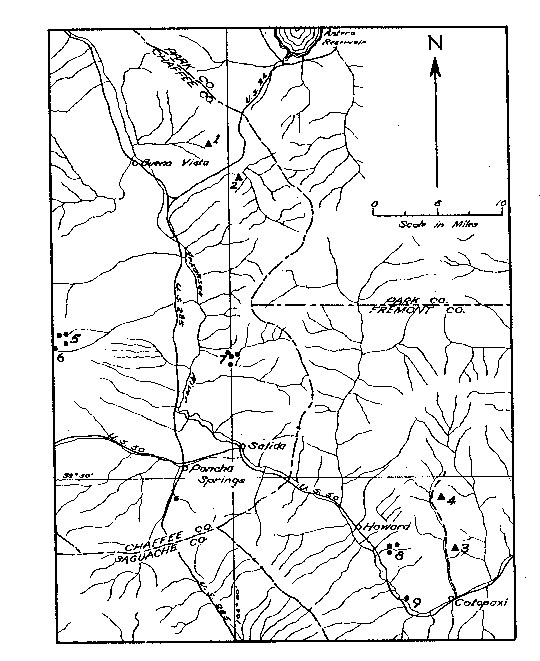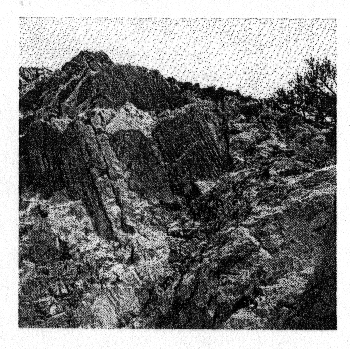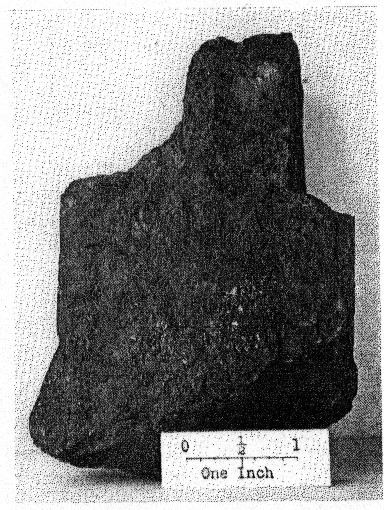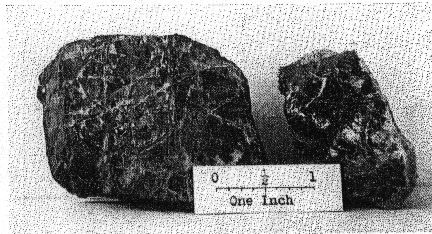| Home | AmMin | GMR | RiMG | Collectors Corner | Directory | Short Courses | |
|
|
|||||||

|
|
Volume 33, pages 64-75, 1948 FLUORITE RARE EARTH MINERAL PEGMATITES OF CHAFFEE AND FREMONT COUNTIES, COLORADO E. WM. HEINRICH University of Michigan, Ann Arbor, Michigan. ABSTRACT A small group of pegmatites in Chaffee and Fremont Counties, Colorado, is characterized by the association of fluorite with the rare earth minerals euxenite monazite allanite, and gadolinite. The deposits, which are differentiated into central and outer zones of contrasting texture, formed chiefly during the magmatic stage. The less common minerals are the result of hydrothermal modification. Fluorite and rare earth minerals are associated in 19 of the 22 pegmatite districts in North America from which fluorite has been reported. This geochernical relationship is emphasized by the widespread occurrence of rare earth elements in fluorites. INTRODUCTION The purpose of this paper is to describe a small group of fluorite and rare earth mineral pegmatites in Chaffee and Fremont Counties, Colorado, and to compare the group with other pegmatite districts. The writer examined the deposits during the summer of 1946 while engaged in field work in south-central Colorado. A part of the field expenses was met by a generous grant from the Brodrick fund of Harvard University. Mr. J. E. Meyers of Canon City, Colorado, acted as guide for the writer and deserves special thanks for his generous assistance. The pegmatite bodies are in southwestern Fremont County and in northeastern Chaffee County, Colorado. The location of the four deposits described in detail, as well as a number of other pegmatites to which reference is made, is shown in Fig. 1. Although the Yard pegmatite locality has been known to mineral collectors for a number of years, the writer could find no description of any of the deposits in the literature. The pegmatite areas are underlain by pre-Cambrian metamorphic and igneous rocks. The metamorphic formations are chiefly mica schist, mica gneiss, and local quartzite and hornblende gneiss. The fluorite-rare earth mineral pegmatites appear to be confined to pre-Cambrian granite that may possibly be correlated with the Pikes Peak granite of the Colorado Front Range. The physical resemblance is close but no age determinations have been made. The pegmatites are found in two areas separated by a large down faulted block of Carboniferous sediments that forms the northern end of the Sangre De Cristo Range. The Trout Creek Pass area is north and west of the end of the range and centers around Trout Creek Pass east of Buena Vista (Fig. 1). The Cotopaxi area lies north of Cotopaxi along the east side of Barnard Creek (Fig. 1).
FIG. 1. Index map showing location of fluorite-rare earth mineral pegmatites in Chaffee and Fremont Counties, Colorado (marked by triangles): 1. Yard pegmatite, 2. Luella pegmatite, 3. Colorado feldspar pegmatite, 4. Pine Ridge pegmatite. The locations of other pegmatite deposits mentioned are shown by circles: 5. Mt. Antero group, 6. Browns Canyon molybdenite pegmatite, 7. Turret group, 8. Howard group, 9. Coaldale pegmatite. YARD PEGMATITE The Yard pegmatite is in the southwestern part of T. 15 S., R. 77 W. and lies about 12 airline miles N. 50° E. of the junction of U. S. highways 284 and 24, which is south of Buena Vista. The deposit is claimed by Ernest Yard of Canon City, Colorado, who worked it in the early 1940's chiefly for feldspar. Many museum specimens of euxenite and monazite also have been obtained. The main workings, which are about 150 feet above a gulch on the southwest slope of a 250-foot hill, consist of an open cut, 100 feet long, 40 feet in maximum width, and 35 feet deep at the face. Two levels have been made. Two trenches serve as entryways and a small narrow cut branches from one side. Near the top of the hill is a narrow, north-trending trench, 15 feet long, also in pegmatite.
FIG. 2. Photograph of biotite sheets along fractures in core of Yard pegmatite, Chaffee County, Colorado. The pegmatite strikes N. 60° E. and dips 60° N.W. In the open cut its is about 70 feet wide, but it narrows toward the crest of hill to 40 feet. It can be traced down the northeast slope for only a short distance; thus the keel of the body may plunge at a steep angle to the west-southwest. The pegmatite is also exposed below the dumps from the main cut and can be followed into the gulch where it is only 15 feet thick. A three-foot thickness crops out across the gentle slope of the southwest side of the gully for 200 feet, at which point the body ends in a pod of white quartz. The total length of the exposure is about 600 feet. The country rock is a light-colored, medium-grained granite with subordinate porphyritic and coarse-grained phases. Locally with a decrease in the amount of biotite and a diminution of the general grain size the rock becomes aplitic. The hanging-wall pegmatite contact is sharp, but, the footwall contact is poorly defined and the two rocks intergrade in some places. In the thickest part of the deposit, i.e., in the open cut, the pegmatite is differentiated into a central zone or core and a surrounding wall zone. The core consists of pods of milky quartz, 6 feet or less in length, and masses of coarsely crystalline microcline as much as 15 feet long. Many of the microcline crystals have been partly removed in mining. The wall zone, which is poorly exposed in the main cut, consists of graphic granite, quartz, microcline, and uncommon, one-inch magnetite crystals in a medium-grained intergrowth. In the gully a 4-foot core of quartz is surrounded by a similar wall-zone rock. Along the margins of the core are local concentrations of fluorite and rare earth minerals associated with tabular bodies of muscovite. Much of the central part of the core has been strongly fractured. Of the several sets of fractures, one of the most prominent strikes N. 50° W. Sheets of biotite as much as 3 feet long, 2 feet wide, and 1 foot thick have formed along many of the cracks (Fig. 2). Similar blades of biotite, some of them 6 feet long, occur in the upper trench, cutting wall-zone pegmatite rich in graphic granite. The primary minerals of the core and the wall zone are quartz, microcline, and magnetite. The other minerals are later and form fracture fillings or replacement masses many of which are clearly related to fractures. The wall-zone pegmatite has been altered by small, patchy replacements and narrow veins in which green muscovite and light colored albite are abundant. Local vugs, four inches deep, which have been formed by solution of microcline, contain small muscovite and quartz crystals, 4 inch long. Some of the muscovite plates have been replaced by bright yellow sericite. Veinlets of purple fluorite, quartz, chlorite, and specular hematite also are present. Much of the wall-zone microcline, which normally is either white or pale pink, has been changed to green by incipient sericitization. Albite, one of the early replacing minerals, is replaced by later chlorite. The sequence of veining and replacement in the wall zone appears to be: 1. Muscovite and albite 2. Purple fluorite, quartz, and chlorite 3. Specular hematite 4. Sericite Around the margins of the core occur local concentrations of monazite, euxenite, fluorite, and plagioclase, usually in the form of one-inch to one-foot pods and clusters of crystals. These masses appear to have formed by replacement of core rock and commonly are localized along a contact between a quartz pod and a microcline crystal. Associated with these masses are tabular veins of muscovite, five feet or less in length. The mica is grayish green in color and occurs in six-inch wedge-shaped blades, marked by ruling and A-structure. Pods of monazite and the closely associated euxenite are surrounded by aureoles of pink to dark red feldspar, a regular feature accompanying the occurrence of these minerals. Series of cracks radiating from a central euxenite aggregate also are conspicuous. Monazite was found in masses as large as 4.5 X 2.5 X 2 inches (Fig. 3), and the largest piece of euxenite obtained measures 2.5 X 2 X 1.5 inches (Fig. 4). The monazite is cut by fractures, some of which are coated by specular hematite (Fig. 3). The euxenite pods are minutely fractured and break easily into many small pieces. Along the fracture surfaces are films of an earthy, buff to greenish material (Fig. 4), a common alteration product of this mineral (Palache et al. 1944, p. 791). A single cluster of three sub-parallel crystals was found, the largest of which is 5/8 inch long, 3/8 inch across, and 1/8 inch thick. The forms present are: a{100}, b{010}, and d{101}.
FIG. 3. Photograph of largest monazite fragment found in Yard pegmatite. The shiny spangles are specular hematite.
Fin. 4. Euxenite from Yard pegmatite. showing fractures filled with typical greenish alteration product. Both monazite and euxenite replace and vein the white plagioclase (calcic albite to sodic oligoclase) and are themselves veined and corroded by white fluorite, red albite, and an unidentified soft yellow-gray mineral. The monazite, which appears to be slightly older than the euxenite, is associated with a few small blebs of gadolinite and is cut by minute veinlets of apatite as well as specular hematite. About 300 pounds of white to buff fluorite has been stockpiled near the mouth of the main cut, but only small amounts of this mineral were observed in place. Lumps 8 inches across are not uncommon. Rare, minute veinlets of purple fluorite transect the white variety. Bismutite is reported to be abundant locally in the deposit. A three-inch piece, presented to the writer by J. B. Leslie of Canon City, Colorado, occurs in quartz and is gray, brown, and green in color. No relicts of the original mineral remain. Malachite stains part of the specimen. According to Mr. Leslie 800 pounds of bismutite has been obtained from this pegmatite. The sequence of formation of the minerals in the replacement pods appears to be as follows: 1. White albite-oligoclase, muscovite 2. Monazite and gadolinite 3. Euxenite 4. White fluorite and red albite 5. Unidentified, soft, gray mineral 6. Purple fluorite, apatite 7. Specular hematite 8. Sericite 9. Bismutite and malachite LUELLA PEGMATITE The Luella pegmatite is 3 miles S. 40° E. of the Yard deposit and just southeast of U. S. highway 24 (Fig. 1). The deposit was claimed on May 1, 1946, by Messrs. C. J. Vesey, C. Miles Martin, and E. Moldenhauer of Denver, Colorado, and it has been worked in the past by Magusson and Sons of Denver for feldspar. The open cut, which is 60 feet long and 20 feet wide, has two levels; the floor, 30 feet below the rim, and an eastern bench 13 feet higher. The pegmatite body strikes N. 67° E. and dips 68° SE. In the cut it is at least 50 feet thick, but 150 feet to the east it thins to 5 feet. The total exposed length is about 250 feet. The footwall contact is not exposed. The hanging-wall contact with the country rock, a coarse-grained porphyritic granite, is generally sharp, except in the entryway to the cut, where a gradational rock is exposed. The well-developed zonal structure includes: 1. A one- to two-inch border zone of fine-grained pink microcline and quartz. 2. A wall zone, five to eight feet thick, consisting of pink microcline masses, one and one-half feet on edge or less, set in a medium-grained matrix of anhedral quartz and pink microcline. 3. A core, 30 feet thick, containing chiefly very coarse blocky microcline in its central part, surrounded by a poorly defined periphery of quartz pods. The open cut has been made in the central microcline-rich part of the core. Rose quartz occurs in the core near its western end. A three-foot inclusion of slightly pegmatitized granite appears in the cut floor. On the footwall side of the core near the southwest corner of the cut is exposed a pod of brick-red plagioclase-rich rock, three by two feet in section. Here the wall zone contains small vugs and abundant fractures, some of which are lined with biotite strips as much as one foot long and three inches thick.. Other cracks are coated by flattened 2-inch garnet crystals. Minerals occurring within the plagioclase unit are muscovite, allanite, euxenite, apatite, hematite, garnet, fluorite, and bismutite. The primary minerals are quartz and microcline. All the other constituents occur in or around a replacement unit localized in wall zone rock. near the footwall contact with the core. The chief feldspar of the pod is red plagioclase (albite to sodic oligoclase), but a few relicts of pink microcline remain. Allanite, which is next in abundance (about 10%), occurs as striated prismatic crystals, as much as an inch thick and several inches long. A single minute crystal of apatite was found along the side of one of the allanite blades. Euxenite is relatively rare; only a few inch fragments were obtained. Green fluorite veins and in places microcline and a few small veinlets of purple fluorite transect plagioclase. During later stages of the hydrothermal activity, solution exceeded deposition, and small vugs formed at the expense of plagioclase, allanite, and green fluorite. Extensive sericitization accompanied the production of the cavities. Late to form were bismutite and supergene calcite and limonite. The sequence of formation of the secondary minerals appears to be: 1. Plagioclase and minor muscovite 2. Biotite and garnet 3. Allanite, euxenite, apatite 4. Green fluorite, purple fluorite 5. Hematite 6. Sericite and vugs 7. Bismutite 8. Calcite and limonite COLORADO FELDSPAR PEGMATITE The Colorado Feldspar pegmatite is in sec. 8, T. 48 N., R. 12 E., and lies four miles N. 5° E. of Cotopaxi. The deposit was quarried in 1939 by the Colorado Feldspar Company of Canon City, who recovered several hundred tons of potash feldspar. The pegmatite has been mined from an open cut 60 feet long, 40 feet wide, and 8 feet deep at the face. Except in the cut, exposures are poor, and part of the pegmatite may be covered by dump material. No contacts are exposed, but from the general configuration of the exposures the body may be flat-lying and irregular in outline. Zoning is poorly developed, and most of a poorly defined 10-foot core of white microcline and massive milky quartz has been removed in mining. A few 2-foot feldspar crystals are still exposed in the cut walls. The outer zone consists of irregular masses of graphic granite and granitic quartz-microcline rock containing a few distorted octahedrons of magnetite, one inch on edge. Much of this material has been attacked by later solutions and replaced by later minerals, including plagioclase, biotite, hematite, fluorite, euxenite, monazite, sericite, and calcite. Near the pegmatite exposures the country rock is a strongly gneissic biotite granite, but in the gully to the south typical Pikes Peak granite is exposed, distinguished by the aligned phenocrysts of red microcline in a coarse-grained matrix. About 1/4 mile south of the cut in the same drainage several small magnetite-bearing pegmatites crop out. A few pieces of euxenite were obtained from one body. The wall zone rock has been replaced in an irregular, patchy pattern by secondary material, the bulk of which is white plagioclase (albite to sodic oligoclase) and biotite. Biotite is especially abundant locally, occurring in aggregates of blades some of which are a foot long and three to six-inches thick. Most of it has been altered to chlorite. White fluorite in three-inch pods also replaces microcline and is in turn veined by purple fluorite. Euxenite and monazite appear to have formed next. The former occurs in two ways: as inch rounded masses, but much more commonly as thin radiating blades, two inches long. Much of the euxenite shows alteration, three stages of which can be recognized; the zone nearest the fresh mineral (and presumably the first stage in the decomposition) is a light brown material with a pitchy luster; the inner zone consists of a substance with a similar luster but yellow in color; and the outer part is made up of a bright yellow, earthy, and friable material. Monazite was found in several four-inch hemispherical masses of radiating crystals. The individual blades are 12 inches long and as much as 4 inch thick at the convex surface, where they are terminated by imperfect crystal faces. Both minerals were found in relative abundance in the eastern part of the deposit. One mass of euxenite weighed 75 pounds. Following the formation of vugs, chiefly by the dissolution of fluorite, specular hematite and pink calcite were deposited in the openings. The former also occurs in small, sharply defined veinlets cutting quartz and feldspar. This stage was also marked by the formation of sericite. With incipient sericitization microcline was changed in color from cream to pale green. PINE RIDGE PEGMATITE The Pine Ridge pegmatite lies nearly 7 miles N. 4° W. of Cotopaxi in sec. 20, T. 49 N., R. 12 E. The deposit was discovered in late 1941 by Mr. Frank Ogden of Vallie, Colorado, who prospected it for feldspar by digging a narrow, shallow trench about 10 feet long. The poorly exposed, narrow pegmatite appears to strike north-south. No contacts were observed. The cut exposes a central unit of brick-red microcline, massive white quartz, and abundant biotite. Gadolinite, associated with white plagioclase, gray fluorite, and green sericite, occurs as a replacement of microcline. As in the other pegmatites described, quartz and microcline are primary. Biotite occurs in blades cutting across the fabric of the quartz-feldspar intergrowth. White sodic oligoclase and rare fluorite cross microcline and appear to be contemporaneous with gadolinite. The rare earth mineral is black with a resinous luster and occurs in masses as large as 20 pounds. The last mineral to form was green sericite. OTHER PEGMATITES IN THE REGION Figure 1 shows the location of other pegmatites in the region. In Group 5 are the Mount Antero-White Mountain pegmatites which have been described most recently by Switzer (1939). These deposits are marked by a hydrothermal beryllium-fluorine phase and are believed to be Tertiary in age. No. 6 is the Browns Canyon quartz-molybdenite pegmatite described by Landes (1934). Pegmatites near Turrett (Group 7) contain late-stage albite, muscovite, garnet, and beryl. Those southeast of Howard (Group 8) are characterized by secondary albite, biotite, muscovite, and garnet. Primary magnetite is exceedingly abundant locally. In the Coaldale pegmatite (No. 9) primary hornblende and hydrothermal epidote were noted. ASSOCIATION OF FLUORITE AND RARE EARTH MINERALS Fluorite and other fluorides have been reported in pegmatites of five districts in Colorado and in 17 other districts in North America. In 19 of these fluorite is associated with rare earth minerals. This relationship is summarized in Table 1. TABLE I. FLUORITE PEGMATITES OF NORTH AMERICA
In North America many pegmatites that contain fluorite also contain rare earth minerals. However, rare earth-bearing pegmatites do not always contain fluorite. Although the study of the pegmatite deposits of this continent is far from complete and the literature is scanty for many districts, this association of fluorite with rare earth elements does not appear to be merely coincidental. Rare earth elements have been detected in fluorites from many different localities: yttrium and ytterbium by Humphreys (1904); samarium and yttrium by Tanaka (1924); yttrium in Amelia, Virginia fluorite by Wherry (1929); europium and ytterbium by Haberlandt, Karlik, and Przibram (1934); lanthanum, cerium, yttrium, and erbium by Ito (1935); samarium by Przibram (1937); cerium and lutetium by Aspland, Brammall, and Leech (1938); and yttrium, lanthanum, cerium, and neodymium by Bray (1942). The low temperature fluorescence of fluorite is considered to result from their content of the bivalent rare earth elements (Przibram, 1937, and Haberlandt, Karlik, and Przibram, 1.935). It is interesting to note that in commercial spectrographic analysis of 425 miscellaneous rock and mineral samples by the Laucks Laboratories (Freeman, 1942) a rare earth element (yttrium) was detected in only one sample - this being vein material "determined to be about 50 per cent fluorite and 40 per cent quartz" (sic). CONCLUSIONS 1. In the Trout Creek Pass-Cotopaxi pegmatite district fluorite is associated with the rare earth minerals euxenite, monazite, allanite, and gadolinite. The pegmatites were formed in two stages: a magmatic stage in which microcline, quartz, and magnetite crystallized and a hydrothermal stage during which the other minerals were formed. 2. In North America pegmatitic fluorite appears chiefly in those deposits that also contain rare earth minerals. This geochemical association is probably not fortuitous, for fluorites from a variety of geological environments and many localities are known to contain rare earth elements. REFERENCES 1. ASPLAND, U. L., BRAMMALL, A., AND LEECH, J. G. C. (1938): Am. Mineral., 23, 415. 2. BRAY, JOSEPH M. (1942): Am. Mineral. 27, 769-775. 3. COX, DOAK C. (1945): Colo. Sci. Soc., Proc., 14, 263-285. 4. CROSS, WHITMAN, AND HILLEBRAND, W. F. (1885) : U. S. Geol. Survey, Bull. 20, 13-39. 5. DELURY, JUSTIN S., AND ELLSWORTH, H. V. (1931): Am. Mineral., 16, 569-575. 6. ELLSWORTH, H. V. (1931): Am. Mineral., 16, 576-579. 7. FREEMAN, GERALD O. (1942): Am. Mineral., 27, 776-779. 8. GILLSON, JOSEPH I,. (1927): Am. Mineral., 12, 307-319. 9. GLASS, JEWELL J. (1935) : Am. Mineral., 20, 741-768. 10. GODDARD, EDWIN N., AND GLASS, JEWELL J. (1940): Am. Mineral., 25, 381-404. 11. HABERLANDT, HERBERT, KARLIK, BERTH, AND PRZIBRAM, KARL (1934) : Sitzber. Akad. Wiss. Wien. Math.-naturw. Klasse, Abt IIa, 143, 151-160. 12.----------Sitzber. Akad. Wiss. Wien, Math.-naturw. Klasse, Abt. IIa, 144, 135-140. 13. HANLEY, JOHN B. (1946): Am. Mineral., 31, 197. . 14. HEINRICH, E. Wm. (1942): Manuscript report in files, U. S. Geol. Survey. 15. HO, T. L. (1935): Geol. Soc. China., Bull. 14, 279-282. 16. JAHNS, RICHARD H. (1946A): New Mexico Bureau Mines and Min. Res., Bull. 25. 17. ------ (1946B): Bull. Geol. Soc. Am., 57, 1208. 18. KERR, PAUL F. (1935) : Am. Mineral., 20, 207. 19. LANDES, K. K. (1932): Am. Mineral., 17, 381-390. 20. LANDES, K. K. (1934) : Econ. Geol., 29, 697-702. 21. MATHEWS, E. B. (1900): Jour. Geol., 8, 214-240. 22. McKINSTRY, H. E. (1921): Am. Mineral., 6, 56-60. 23. OVER, EDWIN, JR. (1929): Rocks and Minerals, 4, 106-107. 24. PALACHE, CHARLES, GERMAN, HARRY, AND FRONDEL, CLIFFORD (1944) : Dana's System of Mineralogy, p. 791. 25. PRZIBRAM, KARL (1937): Zeit. Physik, 107, 709-712. 26. SHALVIN, VINCENT E. (1946): Am. Mineral., 31, 329-345. . 27.SHAUB, B. J. (1946): Am. Mineral., 31, 512. 28. SPENCE, HUGH S. (1930): Am. Mineral., 15, 430-450, 474-496. 29. SWITZER, GEORGE (1939): Am. Mineral., 24, 791-809. 30. TANAKA, T. (1924) : Jour. Opt. Soc. Am. and Rev. Sci. Instr., 8, 501-510. 31. TOLMAN, CARL, AND GOLDICH, SAMUEL S. (1935): Am. Mineral., 20, 229-239. 32. WHERRY, EDGAR T. (1929): Am. Mineral., 14, 299-308. 33. WHITE, GEORGE M. (1935) : Rocks and Minerals, 10, 184-187. * Contribution from the Department of Mineralogy and Petrography, Harvard University, No. 293.
|



